On August 25th 2012, while the eyes of the global space community were focused almost entirely on the happenings in a crater on Mars, a significant event took place approximately 18 billion kilometres (11 billion miles) from Earth. Voyager 1 passed through the heliopause, the boundary between what is regarded as the “bubble” of space surrounding the solar system (heliosphere) which is directly influenced by the Sun, and “true” interstellar space.
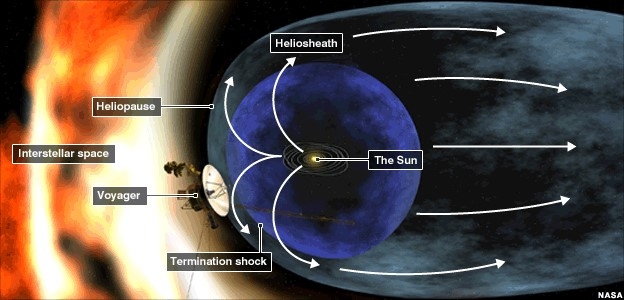
That the spacecraft might be nearing the so-called “bow shock” area where the solar wind meets interstellar space was indicated by engineers and scientists working on the Voyager project in June 2012; however, it was not until September 2013 that NASA JPL felt confident enough in the data they’d received to confirm that Voyager 1 had in fact passed into interstellar space in August 2012, the first man-made object to have done so, some 35 years after having been launched from Earth in what was a highly ambitious programme of deep-space exploration.
The Voyager programme actually had its roots in a much more ambitious programme, the so-called Grand Tour. First put forward by NASA engineer Gary Flandro, The Grand Tour proposed the use of a planetary alignment which occurs once every 175 years, together with the potential to use the gravities of the planets as a means by which space probes could explore the outer planets of the solar system.
The idea of using gravity of the planets to help propel a space craft had first been realised by a young mathematician, Michael Minovitch, in 1961. With the aid of the (then) fastest computer in the world, the IBM 7090, Minovitch had been trying to model solutions to the “three body problem” – how the gravities of two bodies (generally the Earth and the Sun) influence the trajectory and velocity of a third (generally a comet or asteroid) moving through space; something astronomers and mathematicians had long wrestled with.

Through his work, Minovitch showed how an object (or space vehicle) passing along a defined trajectory close to a planetary body could, with the assistance of the planet’s gravity, effectively “steal” some of the planetary body’s velocity as it orbited the Sun, and add it to its own.
At the time, his findings were received with scepticism by his peers, and Minovitch spent considerable time and effort drawing-up hundreds of mission trajectories demonstrating the capability in order to try to get people to accept his findings. But it was not until 1965, when Flandro started looking into the upcoming “alignment” of the outer planets (actually a case of the outer planets all being on the side of the Sun, rather than being somehow neatly lined up in a row) due in the late 1970s, that Minovitch’s work gained recognition.
Recognising the opportunity presented by the alignment, Flandro started looking at how it might be used to undertake an exploratory mission. In doing so, he came across Minovitch’s work and realised it presented him with exactly the information needed to make his mission possible, and so the Grand Tour was born.
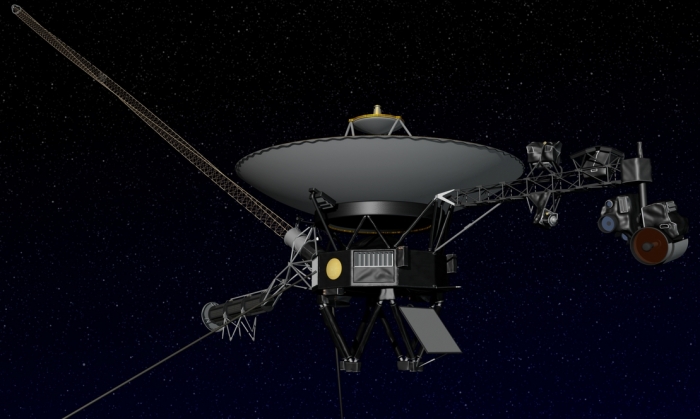
This mission would have originally seen two pairs of spacecraft launched from Earth. The first pair, departing in 1976/77 would form the MJS mission, for “Mariner (then the USA’s most capable deep-space vehicle)-Jupiter-Saturn”. These would fly by Jupiter and Saturn and then on to tiny Pluto; while a second pair of vehicles launched in 1979 which would fly by Jupiter, Uranus and Neptune.
Budget cuts at NASA following Apollo eventually saw the Grand Tour scaled-back to just two vehicles, Voyager 2 and Voyager 1, but the overall intent of the mission remained intact under the Voyager Programme banner, now led by Ed Stone. In the revised mission, both spacecraft would perform flybys of Jupiter and Saturn, with Voyager 2 using Saturn to boost / bend it on towards Uranus and from there on to Neptune, while Voyager 1 would approach Saturn on a trajectory which would allow it to make a flyby of Saturn’s huge Moon Titan, of significant interest to astronomers because of its thick atmosphere. This route would preclude Voyager 1 from reaching Pluto, as it would “tip” the vehicle “up” out of the plane of the ecliptic and beyond even Pluto’s exaggerated orbit around the Sun, and push it onto an intercept with the heliopause.
The Voyager mission commenced on August 20, 1977 with the launch of Voyager 2. with Voyager 1 following on September 5, 1977. Since then, their mission has become legendary, returning some of the most amazing images of the giant planets of the solar system and their myriad moons, together with a considerable amount of data about each of them.
In the 1990s, the faster-moving Voyager 1 “overtook” the older Pioneer deep-space probes in terms of its distance from the Earth. Pioneer had been a programme launched in the early 1970s to explore the asteroid belt, Jupiter, Saturn and (it had been hoped) probe the outer reaches of the heliosphere. Sadly, both Pioneer 10 and Pioneer 11 are no longer active, the former having lost power to its communications array on January 23rd, 2003 when some 12 billion kilometres from Earth, and the latter having ceased communication with Earth at the start of December 1995.
It’s incredible to think that the Voyager mission is 36 years old and is still going – and that the primary phase of the mission lasted just 12 years, ending in 1989 when Voyager 2 passed beyond Neptune, heading out along the plane of the ecliptic towards its eventual encounter with the heliopause (which is thought to be not too far away). Voyager 1’s interplanetary mission phase was even shorter – just 3 years 3 months and 11 days. The rest of its time has been spent on the “interstellar” phase of the mission – 32 years and eight months.
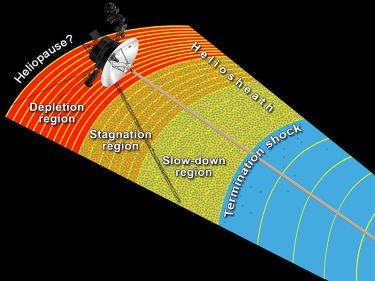
One of the reasons it has taken a while to confirm that Voyager 1 has officially passed into interstellar space and beyond any influence of the Sun is that while the heliopause has long be theorised, no-one has actually been quite sure of where it actually is.
This is perhaps demonstrated in the fact that it was originally thought that Voyager 1 had crossed the termination shock – the point at which the solar wind slows to subsonic speed relative to the Sun – in late 2003, but this was later revised by just over a year, which passage through the termination shock seen as being in December 2004. Even then, a consensus opinion that the vehicle was indeed in the so-called heliosheath – a region of “turbulence” between the termination shock and the heliopause where solar wind and interstellar space are interacting – was not reached until 2005 (as a side note to this, Voyager 2 passed the termination shock in 2007).
Another reason for caution has been due to the more recent Interstellar Boundary Explorer (IBEX) mission, launched in 2008 with the express purpose of studying the boundary between interstellar and solar space. Operating in a high orbit averaging some 191,345 kilometres (118,896 miles) above the Earth, IBEX has produced data which has done much to revise thinking on the nature of the heliopause region.
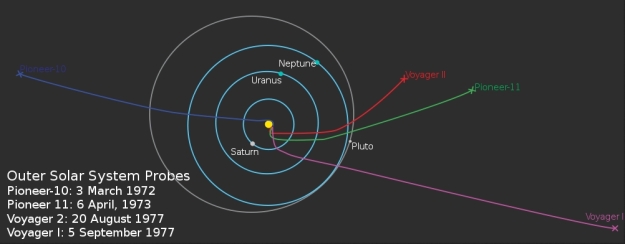
Now Voyager 1 is entering into the true interstellar medium, and if 32 years sounds a long time since its last planetary encounter, it will be another 40,000 before the next. Sadly, by that time, the vehicle’s power systems will have long-since died – it is thought that at the current rate of depletion, the onboard RTG powering Voyager 1 will be unable to supply electrical energy to any of vehicle’s instruments by around 2025. Even so, it is the fastest-moving man-made object currently in existence, moving at some 17 kilometres (11 miles) per second – and will continue to do so long after its power system has expired.
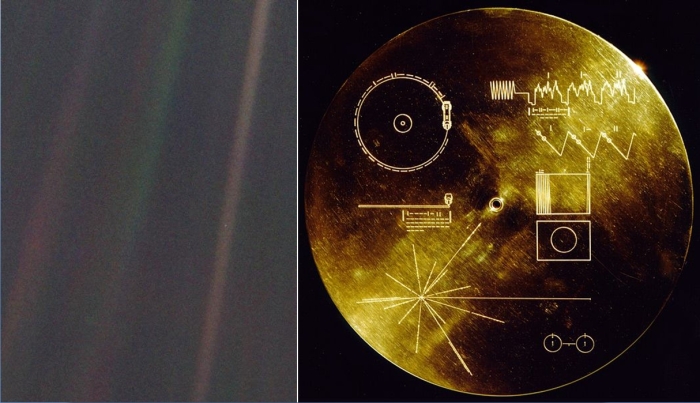
Should either Voyager spacecraft encounter intelligence out among the stars, each carries a golden record on board which contains pictures and sounds of Earth, along with symbolic directions for playing the record and data detailing the location of Earth.
And as they pass out into the deep void beyond the influence ouf our Sun, they are becoming our first physical interstellar ambassadors.
All images courtesy of NASA, unless otherwise indicated.
Thanks Inara! I watched the Ustream press conference yesterday and was amazed and inspired by this remarkable news.
The Voyager Record, even if never picked up by another intelligence, is such an extraordinary cultural milestone and time capsule. The human race has tossed so many objects into earth orbit, solar orbit, crashing and landing into different planets, yet only 4 times in the history of life on earth have we sent objects on trajectories beyond our own solar system. If the sun went nova today, other than radio waves, the only evidence of our culture having existed would be the twin Voyager and twin Pioneer spacecraft and their records and plaques.
If Linden Lab went nova today, of course there would be your blog, my blog, and so many other hundreds and thousands of blogs and websites documenting Second Life and the culture that had existed there. SL wouldn’t be forgotten, still I wonder what “Voyager Record” we have specifically created as a message to future civilizations, and to ourselves?
LikeLike
It’s an amazing feat, given the technology. And the record is an incredible piece of human heritage; as are the plaques on Pioneer 10 and 11. Even if there is no-one out there that comes across one of these craft, I’d like to think that one day, when we have the technology to send humans out among the stars, they might at least catch-up with one of these vehicles and listen to the messages of their ancestors. That as you say, we have at least created a message to ourselves. Particularly in the case of poor Voyager 2. 296,000 years before it’ll encounter Sirius…
LikeLike
BTW, I sort of missed it when they were talking about the temperatures on either side of the heiliopause – crazy high I think – did you catch that info?
LikeLike
Essentially, solar plasma in the heliopause is of very high temperature – around 1,000,000 degrees, but less dense than interstellar plasma (and the temperature is driven up by the interaction of the two). Interstellar plasma (cosmic rays) is much cooler – estimated around 6,000 degrees and more dense.
“Density” here is also relative. In the heliopause, the density of solar plasma is around 0.02 particles per cubic centimetre, and in interstellar space, interstellar plasma has a density of about 0.08 particles per cubic centimetre, so the probes are eaxactly swimming through it :).
LikeLike
Amazing!
So… if we weren’t inside the earth’s atmosphere… what temperature would it be around here??
LikeLike
“Temperature” is actually a complicated subject, as it comes down to radiation heat transfer properties. The average ambient temperature in space is thought to be around 4ºK (about -269ºC).
So the “one million degrees” referred to isn’t that of the space that Voyager is moving through, but the temperature generated as a result of it encountering the low density of solar particles in that space (0.02 particles per cubic centimetre). As a result, Voyager 1 isn’t actually “hot” in the sense we would understand, nor is the space around it. However, as a result of these interactions with the solar plasma, it is going to be radioactive.
In Earth orbit, NASA looks to operate in a temperature range from over 200ºC when a space vehicle is in direct sunlight (and directly interacting with solar particles), to around -160ºC (when it is in the Earth’s shadow, but still subject to interacting with particles in the space around it). On the surface of the Moon, the temperature fluctuates between -173ºC and 117ºC.
Hope that sort-of makes sense.
LikeLike
So for me as a warm blooded mammal sitting on the surface of the earth… “one million degrees” kinda means – “way alien environment that I can hardly imagine!” Sorta?
LikeLike
It’s probably best not to get too hung-up on the temperature references; they are kind-of misleading. Essentially, if you were out in the space Voyager has been occupying, it would actually be, as far as you could tell, terribly cold but horribly radioactive for you.
LikeLike
So, a ship travelling through interstellar space becomes radioactive by its exposure to the stars’ particles? Is that safe for its potential occupants? Or for the planet it might land on?
LikeLike
In essence, any craft and human being operating in space is subject to radiation and its effects. As with all things, and trying to keep this reply short, it comes down to a matter of cumulative exposure, which generally can be managed to varying degrees – at least in the case of solar radiation.
Suffic it to say, I refer to Voyager 1 as being “radioactive” for two reasons. Firstly, it has had a very long cumulative exposure to solar radiation – 36 years’ worth (consider what 36 years of sitting in the sunlight on a beach would do to you). Secondly, since early 2005, it has been passing through a region of space where, despite the low densities involved, it is under the influence of the interaction between solar plasma and cosmic plasma, and this will, again over time, affect the vehicle. Both of these combined are likely to make it the kind of object you’re not going to want to spend any amount of time close to without taking proper precautions – and that’s outside of the fact that it is powered by a decaying lump of Pu-238.
LikeLike
And what does that mean for prolonged manned space travel that might last decades or even centuries?
LikeLike
That’s still being debated.
Currently, it is thought that any astronaut should not be exposed to any more than 4 Sieverts, maximum, of radiation in their career in order to minimise the long-term health risks resulting from such exposure.
As it is, an astronaut on the ISS for 6 months faces a dosage of around 100 millSieverts (mSv) (compared to the 2.4 mSv they would be exposed to on Earth). On a 500+ day mission to Mars aboard a vehicle using current solar shielding capabilities and including transit times and time on the surface, an astronaut could face a dosage of between 500 mSv to 1 Sv.
The exposure on a Mars mission may well be further mitigated through the use of yet-to-be-tried methods of radiation “shielding”. Water, for example, acts as a reasonable blocker for primary gamma radiation (although secondary remains a problem). It’s therefore been theorised that since a human crew – even allowing for recycling capabilities – need to take a considerable amount of water to Mars with them, the water could be used within the walls of their transport to provide an additional shield. There is also work going on to see how polyurethane (another effective “shield” where solar radiation is concerned) might be better integrated into space vehicles to provide protection. This has the benefit of being considerably lighter than water.
Another way of reducing exposure is to reduce the journey time on a Mars mission. Using the chemical propulsion systems available to us today, the transit time to Mars (and back) is 6-8 months, depending on the relative positions of the two planets. But this journey time could be reduced through the use of nuclear propulsion systems, either thermal or electric.
Further into the future, more exotic means of protecting a deep space crew might be used, such as giving their vessel a “magnetic shield” which works to deflect GCRs, etc., in much the same way as the Earth’s magnetic field protects us. And who knows what may have been worked-out by the time we’re in a position to send people whither the Voyagers (and Pioneers) are going?
LikeLike
Is nuclear propulsion safe for the passengers of a spacecraft and, once it lands and/or it needs to take off again, its surroundings?
LikeLike
In terms of crew safety & radiation, yes nuclear propulsion is “safe”, again allowing for adequate shielding. And there would be no need for a nuclear propulsion system to operate within the atmosphere. Essentially, the nuclear vehicle would be pre-fabricated on Earth, boosted to low Earth orbit (LEO) and then assembled / mated to its propulsion system there.
Conventional chemical propulsion (rockets) would still do the grunt work of lifting the payloads for assembly, and also for crew transfers, via either a rocket system or something like a single stage to orbit (SSTO) “space plane”. Similarly, landings / ascents on / from Mars would be handled via conventional means, either leaving the nuclear vehicle in a “parking” orbit (as the Command and Service Module remained in orbit about the Moon during Apollo).
An adoption of a more radical plan, first publicly promoted by Edwin “Buzz” Aldrin, could see two nuclear vehicles in use, constantly “cycling” between Earth and Mars. So the first ship would be sent with a crew, and while they are on their way, the second ship is kitted-out ready to fly to Mars uncrewed. The first ship would then “drop off” its crew on Mars and make an automated return to Earth, while the second vessel waits for the next suitable window to open, flies to Mars and picks up the crew there and returns them to Earth. Meantime, the first vessel arrives back on Earth, is refurbished, takes on a new crew and heads back to Mars. (Aldrin’s plan, called “Mars Cyclers”, could be undertaken without nuclear propulsion as well, the transit times / mission durations would just be longer.)
Such a system is unlikely to be used for the initial missions to Mars, but if humans are to establish a permanent presence there (and in many respects, Mars actually makes for a much better destination than the Moon, as it has a broader range of the materials needed for a high degree of self-sufficiency which are more readily accessible than on the Moon), such a system of “cyclers” could be the key to reducing the overall costs of “mass transit” of people and materiel over time (allowing for the initial expense of establishing them). Of course, by the time that happens, we may well have developed even more exotic means of propulsion.
LikeLike
http://xkcd.com/1189/
LikeLike
Well, it’s not quite that bad! :). But there were a cuple of thimes (as mentioned) when scientists disagreed on whether or not Voyager 1 had passed through the termination shock :).
LikeLike
It’s really good news that Voyager 1 has reached “true” interstellar space and I think there’s about 10 years left before transmitters/instruments will stop working. Hopefully there will be more good things to come from Voyager 1.
hehe 40,000 years to wait before it reaches a star. I hope that someone will see it out there in space. lol
Voyager 2 I guess will be reaching “true” interstellar space soon and that will be amazing.
LikeLike
Voyager 2 is well inside the heliosheath, so the announcement shouldn’t be too far into the future.
As mentioned in the piece, it is believed Voyager 1’s RTG will be able to produce sufficient electrical energy to supply the vehicle’s instruments through until about 2025.
LikeLike